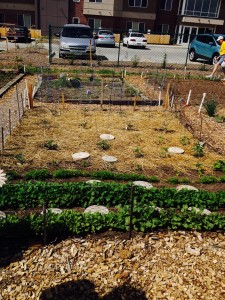This morning we visited Table Top Farms and met Luke and Sally who ran their own organic practice farm. They began as a partnership, but now it is just them two, mostly Sally, and a few employees. Their main focus was community supported agriculture (CSA); in this business model, the farmer sells shares to customers who are then provided with boxes of fresh produce on a weekly basis over a set period of time. It is something that I will look into when I get home because I had never heard of it before, but it sounds like a great option. It both supports your community and improves your nutrition by giving you weekly fruits and vegetables.
Speaking of improving nutrition, we saw the movie Fed Up today and its main focus was on the negative effects of sugar and processed foods have on our diet. It is obvious that we are becoming a more obese nation, beginning as children, which the movie focused on. Also, the main focus seemed to be on how big of a role the food companies play in our every day life and even when we try to combat them, they cover their own butts to ensure we don’t stop eating their products. They have the dollar sign in mind more than they have the nutrition of the people they serve. These big companies use their labels that say 20% less fat to draw us in, but fail to mention all the added sugar that harms us even more. I knew lots of things had sugar, but I didn’t know how much. I think CSAs could play a huge role in reversing some of these statistics if there was just a more informed public. The movie did downplay exercise which caught me a little off guard, because instead of saying everything is okay in moderation and to limit these things, the movie more or less called for them to them to be eliminated, which strikes me as something that will never happen. You cannot make people quit cold turkey on sodas, candies, and fast food, but if you keep them informed as well as give them healthy alternatives, a change may occur. I do agree with the movie that the change needs to start in the public school lunch rooms. If kids learn healthy alternatives they may take them home with them or encourage their parents to eat better as well. If not, they at least get one healthy meal a day.
The BIG protest of the day, also known as the March Against Monsanto, was no march. It was not the wild protest with fire and signs and screaming that I was expecting. It was a calm, small group of people who were wanting foods containing GMOs to be labeled as well as ending the use of pesticides. We did see the community garden which was cool because it gave people living in apartments a place to garden. That was my second favorite part of the protest. My favorite would have to be making the bombs. We made seed bombs out of papier mache and flower seeds. You roll the seeds up in the paper, squeeze out the water, and then throw it in an abandoned lot to make the wild flowers grow and make the scene a little more beautiful. That was about as wild as the protest got…


